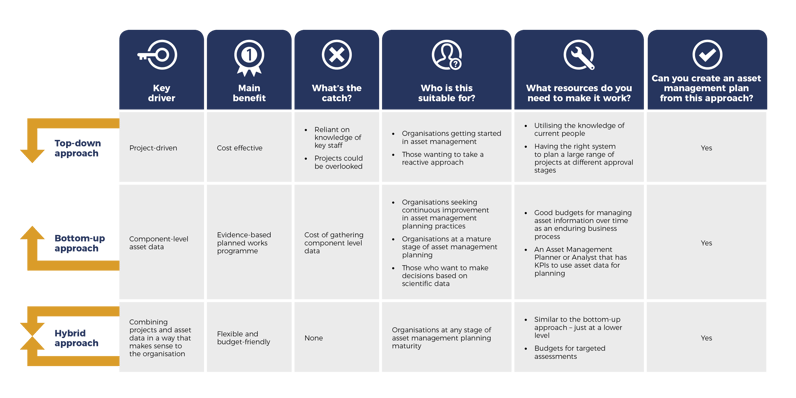Best Approach for Asset Management Planning for Property
At SPM Assets we often talk about following two approaches to asset management planning for property: top-down, and bottom-up. Both are valid – but how do you know which is best for your organisation? And how do they help with creating a good, pragmatic property asset management plan? SPM Assets CEO Steve Lyons explains how they both work, and which approach could be best in which instance.
To view this image enlarged, click here.
What is ‘bottom-up’ asset management planning?
This could be seen as the more traditional approach to asset management planning. It’s based on having component-level evidence (results from a detailed property assessment) to support possible projects. An organisation would typically do a property condition assessment that includes both the condition of components and the performance of the building, to determine the overall quality of the building from its parts up.
Bottom-up planning is what most of SPM Assets’ customers have been doing for the past couple of decades. The process is well described in the IPWEA guidance material, i.e. identify, describe, and assess the components of a building – components that are usually renewed, replaced and maintained. The analysis enables you to establish a lifecycle and maintenance cost forecast well into the future, providing the evidence to support planned projects. That's the bottom-up approach.
What is the ‘top-down’ approach?
The top-down approach to asset management planning doesn’t necessarily need any component-level data; rather, it can be a project-driven method. Asset managers use collective knowledge alongside organisation level goals to identify their planned-projects – this type of planning could be just one year ahead, or maybe extended to five years. The project list is based on the knowledge held by facility managers, asset managers, and contracted service providers, and generally, there is little component-level evidence to support those projects. So invariably, the top-down method only addresses known issues with buildings.
For example, facility managers would be aware of an aging air conditioning system that frequently needs repairs and call-outs, so a replacement project would be added to next year’s budgeting spreadsheet or added to the asset management plan (AMP). Typically, asset managers would ask for feedback across facility managers and building occupiers for their list of issues that need to be addressed. They would also consider the strategic and tactical needs of the buildings (both now and into the future) to determine other non-condition projects such as extensions, reconfigurations, modernisations and new builds. All these ideas and projects come together to meet the objectives of the organisations – the main difference to the bottom-up approach, is that many of the projects have limited component level data to support the needs.
The main benefit of the top-down approach is that the cost of doing infield assessments is minimised. After all, if you have, say, 100 facilities across an organisation, it might cost a couple of hundred thousand dollars to do bottom-up assessments and planning. With the top-down approach, you can target your infield assessment work at a minimal cost.
However, the drawback is the reliance on people’s opinion and judgement. And any knowledge that isn’t stored centrally could be lost when a key team member leaves an organisation.
Where the cost of gathering the component-level data can be seen as a drawback for many organisations, it’s offset by the value of having that information – you can only manage what you measure. If you have good data, you have the confidence that you’re doing the right projects, at the right times, and for the right reasons. The value of that can be significant, and it’s what makes the bottom-up approach so robust. You’re using scientific methods for your planning, rather than relying on incomplete knowledge held by key people that could leave next week.
What’s the ideal scenario – especially if you’re dealing with limited funds and resources?
The ideal scenario is when the top-down and bottom-up approaches are combined. This is what happens in practice - as every asset manager approaches this differently, and in a way that suits them.
Organisations that are more mature with their asset management planning data, systems and processes, have implemented effective asset information management business processes that maintain and improve data over time. This then forms the basis for lifecycle analysis to determine future planned projects. However, there are only a limited number of asset-intensive organisations that can afford this approach.
While many organisations aspire to the bottom-up approach, they are restrained by limited funds and resources. However, they usually do a great job identifying their planned projects using the top-down approach. We are seeing these organisations moving in the right direction – committing to a planned (rather than reactive) approach, meaning that they would select specific projects for targeted component-level evidence-based assessments.
The reality is that you will structure your approach to meet your organisation’s business needs or direction provided. If your governing body sees the value in having the evidence to drive your planned works programme, you may then gain the resources to implement. But if asset management planning has yet to become part of your organisation’s strategic agenda, while you see the benefits, you could implement a mixed approach that builds knowledge over time with targeted assessments.
Having an asset management plan makes a difference
Regardless of whether a top-down, bottom-up, or a hybrid approach is taken, an asset management plan still needs to be written. In fact, more and more organisations are finding that they need to write an asset management plan and one that’s aligned with ISO-55000.
Many asset managers delay writing the plan because they think they need to collect the bottom-up data first, but you don’t actually have to wait for that. You can take a top-down approach and use other data sources within that plan. Just list the projects and link them back to the levels of service standards to identify the reasons why those projects are needed.
Where the asset management plan describes your assets, service level standards, lifecycle forecasts, future demand, and risks, it’s main purpose is to identify the ‘financial consequences of asset ownership’ – in other words, how much money is needed to improve and maintain your properties over time. This can be written at any stage with or without component level asset data – you just need to have your list of projects linked to your levels of service standards (the drivers) and your organisation’s objectives (the reason why).
Keep in mind that asset management plans should be updated every year, which enables you to continually improve your data, assumptions and processes.
Which method is right for you?
Each method has strengths. Top-down asset management planning is based on a list of projects and is a more cost-effective approach. Bottom-up asset management planning begins with component-level data to identify projects. This requires more resources, but the cost is offset by the value of having that data. A hybrid approach combines both in a way that makes sense to the needs of an organisation.
Either a hybrid approach or the bottom-up method is recommended for organisations that see the value in moving to a planned approach, but ultimately, any approach can be implemented to write a meaningful asset management plan that’s aligned with ISO-55000, regardless of the organisation’s stage of maturity.
Subscribe to our Broadcast
Our monthly newsletter featuring asset management tips and insights, and the latest SPM Assets news.

